 Research Article
Research Article
Effect of Calcined Clay on Fresh and Hardened Properties of Self-Compacting Concrete (SCC)
Kwabena Boakye and Morteza Khorami*
Faculty of Engineering, Environment & Computing, Coventry University, UK
Morteza Khorami, Faculty of Engineering, Environment & Computing, Coventry University, UK.
Received Date:January 24, 2023; Published Date:February 07, 2023
Abstract
The utilization of supplementary cementitious materials (SCM) such as calcined clays in self-compacting concrete (SCC) could reduce the quantity of cement as well as providing crucial environmental benefits. This study aims at investigating the influence of calcined clay on the fresh and hardened properties of SCC. Ordinary Portland cement was partially replaced with calcined clay at replacement dosages of 10%, 20% and 30% by weight. Fresh SCC properties conducted were slump flow, L-box and J-flow tests. Compressive strength, split tensile strength and flexural strength tests were evaluated after 7 and 28 days curing. A relationship between compressive strength and split tensile strength was drawn. Workability was found to decrease with increasing calcined clay content. At 28 days, SCC containing 10% calcined clay outperformed the reference concrete but began to decline when replacement was increased to 20% and 30%. Optimum replacement was found to be 20%.
Keywords:Self-compacting concrete; Calcined clay; workability; Split tensile strength; Pozzolan; Compressive strength
Introduction
Self-compacting concrete (SCC) is known, in recent times, to be one of the construction industry’s significant additions [1]. An intriguing characteristic of SCC is its ability to flow freely and occupy its mould under its own weight without suffering segregation. Selfcompacting concrete is mostly criticized for being more costly than concrete that has undergone vibration [2]. However, when compared to conventional concrete, the use of SCC is possibly cheaper due to the potential reduction in labor, cost of vibrator and total time needed to cast [3]. In modern times, a variety of waste products are employed as by-products in the production concrete, including metakaolin, ground granulated blast furnace slag (GGBS), calcined clays, waste plastic, etc. These products, which are mostly recycled, can be utilized in any of the fundamental components of concrete. If the appropriate ratio is established, partially or wholly replacing concrete materials with these products not only significantly reduces the overall cost of construction but also enhances relevant properties of the concrete that is produced [4-6].
The characteristics of cementitious material in their fresh form are significantly influenced by clays. They have been discovered to boost the green strength of concrete even when added in small amounts [7]. Although the mechanics are not well understood, research has indicated that adding clays to cement paste increases flocculation strength and floc size [8], which would appear to increase stiffness. Since calcination requires less energy to activate the clay than cement production does and since it is readily available worldwide, calcined clays have gained popularity in recent years as an alternative to the massive usage of cement. A thermal treatment between 700 and 900 °C can be used to produce it. Several studies have been conducted into the use of calcined clay and have been found to improve strength, workability and durability properties [9-17]. In this work, experiments were conducted to verify the effect of calcined clay (in varying percentages) on fresh and hardened properties of self-compacting concrete. Several studies have been conducted into the utilization of supplementary cementitious materials such as fly ash, metakaolin and GGBS in SCC but there appears to be little information on the use of calcined clays in SCC. Properties such as slump, flow test, compressive strength, flexural strength and split tensile strength have been determined and discussed.
Experimental Study
Materials and methods
A grade 42.5 ordinary Portland cement (OPC), manufactured by the Heidelberg Group and conforming to EN 197-1 standards was used for the concrete mixes. Calcined clay was prepared in the laboratory by heat-treating the raw clay material at a temperature of 700 °C for 3 h at a rate of 10 °C per h. The calcined clay was left to cool inside the kiln for 24 h and sieved to obtain a fineness of 75 μm, as seen in Figure 1. The calcining temperature was selected based on the works of Du & Pang [18]. The x-ray diffraction (XRD) analysis of the calcined clay was conducted using a Siemens D5000 diffractometer. Figure 2 shows the XRD patterns of the calcined clay. As expected, dominant among the phases identified was quartz. Other relevant phases discovered are elite, smectite and meta kaolinite. The elemental composition of the calcined clay and the OPC was analyzed using the x-ray fluorescence (XRF) spectrometer (Spectro X-lab 2000) and presented in Table 1. The calcined clay could be considered as chemically suitable according to ASTM C618 [19]. Fine and coarse aggregates (of sizes 9 mm – 12 mm) were obtained from local suppliers. Particle size distribution of the fine and coarse aggregates are shown in Figure 3 (Figures 1-3) (Table 1).
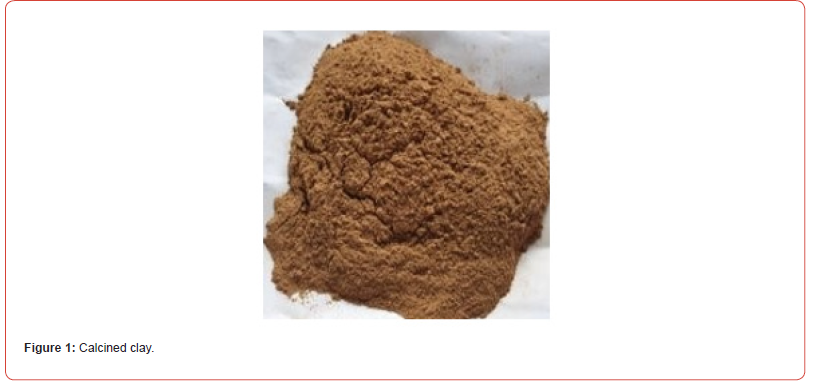


Table:1Chemical composition of cement and calcined clay.
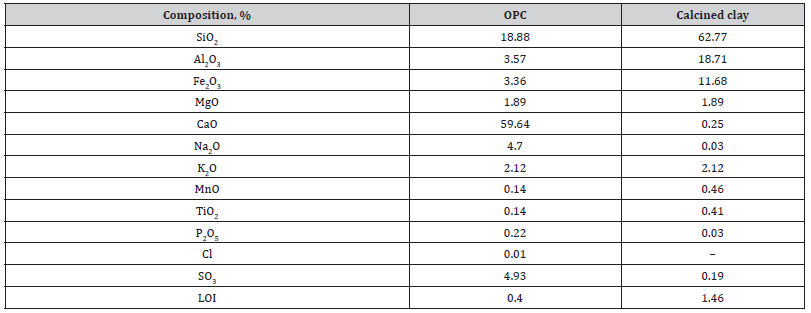
Mix proportions
The reference concrete was designed to obtain a minimum 28 days compressive strength of 32 MPa using a mix ratio of 1:1.75:1.5 and a water-to-cement ratio of 0.4. To achieve workability, 1% superplasticizer was added to the concrete mix. OPC was partially replaced with calcined clay in percentages of 10%, 20% and 30% by weight. Recommendations by EFNARC [20] were considered for all concrete mixes. For fresh concrete properties, slump flow test (BS EN 12350-8) [21], viscosity (T500 flow time), the L-box test (BS EN 12350-10) [21] and J-ring test (BS EN 12350-12) [22] were employed. To determine the hardened properties, 150×150×150 mm concrete cubes were prepared to determine compressive strength of the blended SCC using ASTM C39 [23]. Beams of sizes 500×150×150 mm were prepared to determine flexural strength with reference to ASTM C78 [24]. Cylinders of diameter 100 mm and length 200 mm were moulded for the split tensile test per ASTM C496 [25]. The mix proportions of the SCC are shown in Table 2. Figure 4 shows calcined clay blended cement SCC (Table 2) (Figure 4).
Table:2Mix proportion of SCC.

OPC – ordinary Portland cement; CC10 – 10% calcined clay; CC20 – 20% calcined clay; CC30% - 30% calcined clay; CA – coarse aggregate
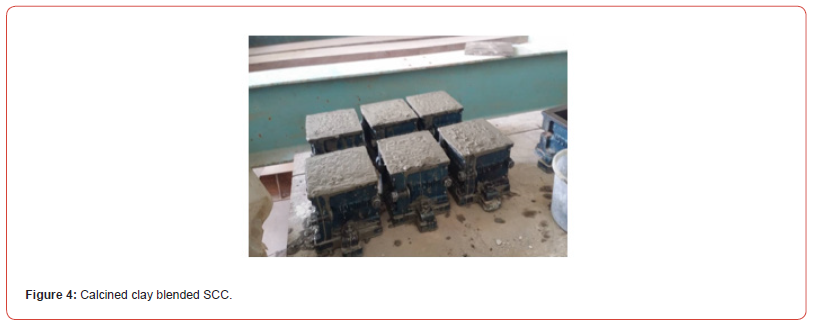
Results and Discussion
Fresh SCC properties
Slump flow test: The relationship between slump flow of the SCC and calcined clay content is represented by a regression line shown Figure 5. The diameters of the different mixes were all found between 600 and 780 mm, which is an indication of good workability as recommended by EFNARC [20]. it was observed that, the slump diameter decreased with increasing calcined clay content. the slump flow of the reference concrete was found to be 780 mm. This was systematically reduced by 7.7%, 16.7% and 23.1% respectively at 10%, 20% and 30% respectively. The decrease in slump flow is attributed to the high surface area of the calcined clay particles [12] which is also known to consume more water in mortar and concrete mixes [14]. This outcome is similar to results obtained by previous studies utilizing other supplementary cementitious materials [26-28]. The time required to reach a 50- cm flow diameter, usually referred to as T 50, during the slump flow experiments can be used to estimate viscosity as well. This is the time it takes for the concrete to flow to the testing plate. The reference concrete recorded the least time (2.8 s) whereas the 30% calcined clay concrete obtained the longest time of 4.5 s. These time values were all found within the 2 – 5 s limits set by EFNARC [20]. Figure 6 presents the T50 of the SCC with varying percentages of calcined clay (Figures 5,6).


L-box test: The L-box test is mostly used to determine the ability of self-compacting concrete to move through restricted spaces without being blocked or suffering segregation. It is a ratio of the height reached by the SCC at the horizontal section of the L-shaped box to the concrete left in the vertical section. Figure 7 is a regression line showing a relationship between calcined clay content in the SCC and their corresponding L-box values. It is seen that the L-box values continuously decreased with increasing calcined clay content. This means that, as calcined clay content increased, However, all the values obtained were above the minimum 0.8 and below the maximum 1.0 recommended by EFNARC [20]. The findings show that as the amount of calcined clay increased in the mix, flow resistance likewise increased, decreasing the capacity of concrete to travel through it [28]. This result is consistent with the work reported by other researchers [1,27] (Figure 7).

J-ring test: This test is used in combination with the slump flow test to estimate the passing ability self-compacting concrete through restrictions such as reinforcement. Figure 8 shows the J-ring slump flow together with the blocking index of SCC incorporated with calcined clay. The reference and blended cement SCC recorded J-ring diameters of 800 mm, 750 mm, 700 mm and 650 mm respectively. The J-ring diameters consistently decreased with increase in calcined clay content. The blocking index followed the same trend. This indicates a reduction in the passing ability of the concrete with increasing calcined clay percentage (Figure 8).
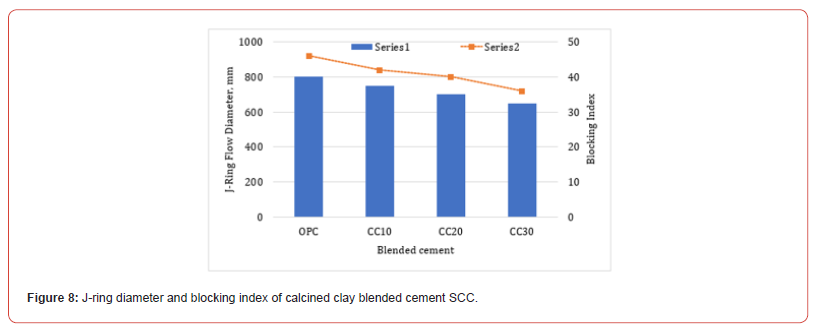
Hardened SCC properties
Compressive strength
The 7 and 28 days compressive strength results of the selfcompacting concrete is shown in Figure 9. The reference concrete obtained a 7-day strength of 24.2 MPa which consistently decreased as calcined clay content increased in the mix. SCC containing 10%, 20% and 30% calcined clay recorded loss of strength of 16.5%, 24.5% and 37.6% respectively. The reduction in strength could be due to dilution effect and unreacted silica in the calcined clay concrete mix at 7 days [17,29]. However, at 28 days, SCC containing 10% calcined clay outperformed the reference concrete but began to decline when replacement was increased to 20% and 30%. This increase in strength is as a result of the pozzolanic reaction between the constituents of the calcined clay and the cement to produce extra calcium silicate hydrates (C-S-H) which improves strength [30]. Beyond 10% replacement, the calcined clay behaved as a filler and could not contribute to strength development [31,32] (Figures 9).

The flexural strength, as shown in Figure10, followed a similar decreasing order trend like the compressive strength at 7 days. At 28 days, flexural strength increased by 7.7% when cement content was replaced by 10% calcined clay (CC10). This increment was maintained at 20% (CC20) but declined at 30% replacement (CC30). The split tensile strength is presented in Figure11. Tensile strength decreased in increasing calcined clay content at 7 days. When the curing period was extended to 28 days, tensile strength increased at 10% replacement. Beyond 10%, split tensile strength decreased in increase in calcined clay content (Figures 10-12).
The relationship between tensile strength and compressive strength of the SCC mixes at 7 and 28 days is shown in Figure 12. The overall R2 value is 0.9907. As curing age increases, the R2 value gets closer to 1.
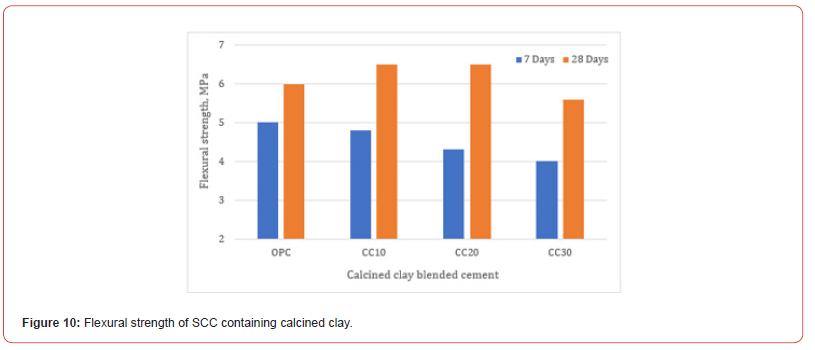

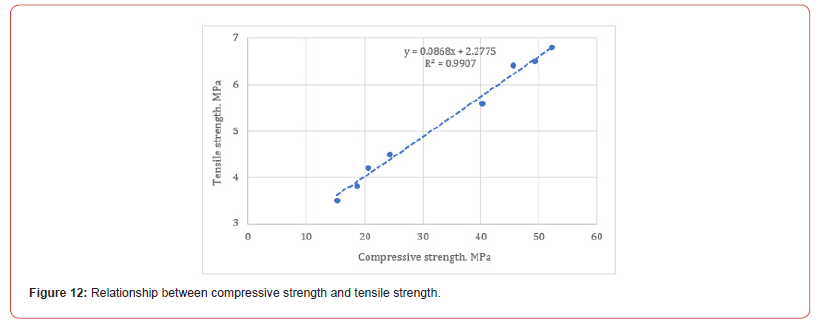
Conclusion
This study examines the behaviour of SCC containing calcined
clay. The blended cement was prepared by replacing cement with
10%, 20%, and 30% calcined clay. The following conclusions are
made after studying the effect of calcined clay fresh and hardened
SCC properties:
1. Workability deceased with increasing calcined clay
content. All batches containing calcined clay, however, showed
enhanced viscosity, passing ability and overall workability. All
mixes were found within limits set by EFNARC.
2. At 7 days, the reference concrete consistently decreased in
compressive strength as calcined clay content increased in the
mix. SCC containing 10%, 20% and 30% calcined clay recorded
loss of strength of 16.5%, 24.5% and 37.6% respectively. At
28 days, SCC containing 10% calcined clay outperformed the
reference concrete but began to decline when replacement was
increased to 20% and 30%.
3. At 28 days, flexural strength increased by 7.7% when
cement content was replaced by 10% calcined clay (CC10). This
increment was maintained at 20% (CC20) but declined at 30%
replacement (CC30).
4. Split tensile strength decreased in increasing calcined clay
content at 7 days. When the curing period was extended to 28
days, tensile strength increased at 10% replacement. Beyond
10%, split tensile strength decreased in increase in calcined
clay content.
5. Optimum calcined clay replacement was found to be 20%.
Acknowledgments
None.
Conflict Interest
No conflict of interest.
References
- Ouldkhaoua Y, Benabed B, Abousnina R, Kadri E, Khatib J (2020) Effect of using metakaolin as supplementary cementitious material and recycled CRT funnel glass as fine aggregate on the durability of green self-compacting concrete. Constr Build Mater 235: 117802.
- Barluenga G, Giménez M, Sepulcre A, Palomar I (2018) Effect of full-scale pumping at early age and on hardened microstructure and properties of SCC with fly ash in hot-dry curing conditions. Constr Build Mater 191: 1128-1138.
- Gill AS, Siddique R (2017) Strength and micro-structural properties of self-compacting concrete containing metakaolin and rice husk ash. Constr Build Mater 157: 51-64.
- Neißer-Deiters A, Scherb S, Beuntner N, Thienel K (2019) Influence of the calcination temperature on the properties of a mica mineral as a suitability study for the use as SCM. Appl Clay Sci 179: 105168.
- Babbar S, Behara RS, Koufteros XA, Wong CWY (2018) Charting leadership in SCM research from Asia and Europe. Int J Prod Econ 203: 350-378.
- Taylor-Lange SC, Lamon EL, Riding KA, Juenger MCG (2015) Calcined kaolinite–bentonite clay blends as supplementary cementitious materials. Appl Clay Sci 108: 84-93.
- Gao X, Kawashima S, Liu X, Shah SP (2012) Influence of clays on the shrinkage and cracking tendency of SCC. Cement and Concrete Composites 34: 478-485.
- He C, Osbaeck B, Makovicky E (1995) Pozzolanic reactions of six principal clay minerals: Activation, reactivity assessments and technological effects. Cem Concr Res 25: 1691-1702.
- Ferreiro S, Herfort D, Damtoft JS (2017) Effect of raw clay type, fineness, water-to-cement ratio and fly ash addition on workability and strength performance of calcined clay – Limestone Portland cements. Cem Concr Res 101:1-12.
- Ferreiro S, Canut MMC, Lund J, Herfort D (2019) Influence of fineness of raw clay and calcination temperature on the performance of calcined clay-limestone blended cements. Appl Clay Sci 169: 81-90.
- Zhou D, Wang R, Tyrer M, Wong H, Cheeseman C (2017) Sustainable infrastructure development through use of calcined excavated waste clay as a supplementary cementitious material. J Clean Prod 168: 1180-1192.
- Parashar AK, Gupta N, Kishore K, Nagar PA (2021) An experimental investigation on mechanical properties of calcined clay concrete embedded with bacillus subtilis. Materials Today: Proceedings 44: 129-134.
- Gobinath R, Awoyera PO, Praveen N, Babu VA, Sai PS, Prathibha K (2021) Effects of calcined clay on the engineering properties of cementitious mortars. Materials Today: Proceedings 39: 110-113.
- Huang W, Kazemi-Kamyab H, Sun W, Scrivener K (2017) Effect of replacement of silica fume with calcined clay on the hydration and microstructural development of eco-UHPFRC. Mater Des 121: 36-46.
- Muzenda TR, Hou P, Kawashima S, Sui T, Cheng X (2020) The role of limestone and calcined clay on the rheological properties of LC3. Cement and Concrete Composites 107: 103516.
- Schulze SE, Rickert J (2019) Suitability of natural calcined clays as supplementary cementitious material. Cement and Concrete Composites 95: 92-97.
- Alujas A, Fernández R, Quintana R, Scrivener KL, Martirena F (2015) Pozzolanic reactivity of low grade kaolinitic clays: Influence of calcination temperature and impact of calcination products on OPC hydration. Appl Clay Sci 108: 94-101.
- Du H, Pang SD (2018) Value-added utilization of marine clay as cement replacement for sustainable concrete production. J Clean Prod 198: 867-873.
- ASTM Committee C-09 on Concrete and Concrete Aggregates (2013) Standard specification for coal fly ash and raw or calcined natural pozzolan for use in concrete. ASTM international.
- EFNARC F (2002) Specification and guidelines for self-compacting concrete. European federation of specialist construction chemicals and concrete system.
- British Standard Institution (2009) Testing Fresh Concrete. Slump-Test.
- EN BS (2010) Testing Fresh Concrete-Part 12: Self-Compacting Concrete-J-Ring Test.
- ASTM International Committee C09 on Concrete and Concrete Aggregates (2017) Standard Test Method for Splitting Tensile Strength of Cylindrical Concrete Specimens 1. ASTM international.
- ASTM A (2018) C78/C78M-18 Standard Test Method for Flexural Strength of Concrete Using Simple Beam with Third-Point Loading. West Conshohocken: ASTM International.
- Singh H, Siddique R (2022) Utilization of crushed recycled glass and metakaolin for development of self-compacting concrete. Constr Build Mater 348: 128659.
- Mim NJ, Meraz MM, Islam MH, Noroozinejad Farsangi E, Mehedi MT, et al. (2023) Eco-friendly and cost-effective self-compacting concrete using waste banana leaf ash. Journal of Building Engineering 64: 105581.
- Sandhu RK, Siddique R (2017) Influence of rice husk ash (RHA) on the properties of self-compacting concrete: A review. Constr Build Mater 153: 751-764.
- Adesina A (2020) Recent advances in the concrete industry to reduce its carbon dioxide emissions. Environmental Challenges 1: 100004.
- Boakye K, Khorami M, Saidani M, Ganjian E, Dunster A, et al. (2022) Mechanochemical characterization of calcined impure kaolinitic clay as a composite binder in cementitious mortars. Journal of Composites Science p.6.
- Lothenbach B, Scrivener K, Hooton RD (2011) Supplementary cementitious materials. Cem Concr Res 41: 1244-1256.
- Tironi A, Scian A, Irassar E (2017) Blended Cements with Limestone Filler and Kaolinitic Calcined Clay: Filler and Pozzolanic Effects. Journal of Materials in Civil Engineering 29: 1-8.
- Rojo-López G, González-Fonteboa B, Martínez-Abella F, González-Taboada I (2022) Rheology, durability, and mechanical performance of sustainable self-compacting concrete with metakaolin and limestone filler. Case Studies in Construction Materials 17: e01143.
-
Tianzhong Ma, Xiaohui Yang, Weixiong Zhang, Chendong Sun. Catastrophic Mechanism and Stability Analysis of Jiangdingya Landslide in Zhouqu County, Gansu Province, China. Cur Trends Civil & Struct Eng. 7(3): 2021. CTCSE.MS.ID.000718.
-
Landslide, Catastrophic mechanism, Stability analysis, Geological environment, Geological structure, Topography, Landslide
-

This work is licensed under a Creative Commons Attribution-NonCommercial 4.0 International License.
- Abstract
- Introduction
- Natural Geological Structure
- Evolution History of Landslide
- Development Characteristics of Jiangdingya Landslide
- Analysis of Catastrophe Mechanism of Landslides
- Stability Analysis of Landslide
- Safety Treatment of Landslide
- Conclusion
- Acknowledgement
- Conflicts of Interest
- References






